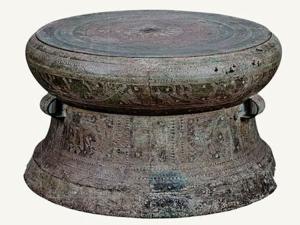Through thousands of years of history, to form “Vietnam” as it is today, the national name of our country has had to go through many ups and downs…
The national title is always one of the most sacred names for each nation, each person. It affirms the existence and sovereignty of a nation, shows the consciousness and pride of each nation as well as equality with other countries in the world. Through thousands of years of history, in order to form “Vietnam” as it is today, the national name of our country has had to go through many ups and downs… Discover Magazine would like to introduce a series of articles by researchers and journalists. , Dr. Nguyen Anh Hung on the national name of our country in different periods.
From the beginning of the Bronze Age, Vietnamese tribes had settled firmly in the North and the North Central. At that time, there were about 15 Vietnamese tribes living mainly in the Northern Midlands and Delta, dozens of Au Viet tribes living mainly in the North Viet Nam. In many places, the Lac Viet and the Au Viet live intermingled with each other, alongside other populations.
Due to the need for water treatment, the need to resist foreign invasion and the increasing economic and cultural exchange, the tribes living close to each other tend to gather and unite. Among the Lac Viet tribes, the Van Lang tribe is the most powerful. The leader of this tribe was the one who unified all Lac Viet tribes, founded the Van Lang country, proclaimed himself king – which the old history called Hung Vuong – and his descendants continued to inherit the title for many generations. there.

Dong Son bronze drum – A symbol of Vietnamese culture.
Based on historical documents, it is possible to temporarily identify the area of Van Lang country , corresponding to the North and North Central regions of our country today, along with the southern part of Guangdong and Guangxi (China). The time of existence of Van Lang country was from the beginning of the first millennium BC (BC) to the 3rd century BC.
In 221 BC, Qin Shi Huang invaded the land of all Vietnamese groups. Thuc Phan – leader of the alliance of Au Viet tribes – was honored as the leader of the war against Qin. In 208 BC, the Qin army had to withdraw. With his authority, Thuc Phan proclaimed himself king (An Duong Vuong), united the Lac Viet and Au Viet tribes, and established Au Lac country .
In 179 BC, Trieu Da – King of Nam Viet – launched an army to capture Au Lac. An Duong Vuong’s resistance failed. During the next 7 centuries, although the feudal forces of the North took turns to colonize and divide our country into many continents and districts with different names that they gave, but the name “Au Lac” could not be erased. in the consciousness, emotions and daily activities of our people.
In the spring of 542, Ly Bi rebelled against the Luong army and liberated the territory. In February 544, Ly Bi was crowned Emperor, giving the country the name Van Xuan , affirming national pride, independent spirit and wishing the country to be sustainable forever.
The Ly Bi government did not last long and then fell under the domination of the Chinese courts (from 602). The national name Van Xuan was crushed and restored only after Ngo Quyen defeated the Southern Han army with the victory of Bach Dang in 938, ending the Northern domination period.
In 968, Dinh Bo Linh pacified the army of sand bases, unified the country, ascended the throne and changed the country’s name to Dai Co Viet (big Viet country). This national title was maintained during the Dinh (968-979), Early Le (980-1009) and early Ly (1010-1053) dynasties.
In 1054, on the occasion of the great auspicious occasion of the appearance of a bright star that went out for many days, the Ly dynasty changed the country’s name to Dai Viet and the national title Dai Viet was kept until the end of the Tran dynasty.
In March 1400, Ho Quy Ly deposed Tran Thieu De, founded the Ho Dynasty and changed the country’s name to Dai Ngu (“du” in ancient language means “peaceful” ). That national title existed until the Ming invaders defeated the Ho Dynasty (April 1407).
After 10 years of resistance (1418-1427), Le Loi’s anti-Minh uprising was completely won. In 1428, Le Loi ascended the throne, renamed the country Dai Viet (our territory at this time to the south has reached Hue). The national title Dai Viet was kept throughout the Later Le Dynasty (1428-1787) and the Tay Son Dynasty (1788-1801).
In 1802, Nguyen Anh was crowned, opening the Nguyen Dynasty and changing the country’s name to Vietnam . The national name of Vietnam was fully recognized diplomatically to become official in 1804. However, the two words “Vietnam” appeared quite early in our country’s history.
Right from the end of the 14th century, there was a set of books titled Vietnam The Chi, compiled by Poinsettia Ho Tong Thoc. Nguyen Trai’s book Du Geography (early 15th century) repeatedly mentions the two words “Vietnam”. This is also clearly mentioned in the works of Trang Trinh Nguyen Binh Khiem (1491-1585), for example, right at the beginning of the book Trinh Tien Tien Quoc Van Van, there is a sentence: “Vietnam started to build the foundation”.

National coat of arms of Vietnam.
The word “Vietnam” is also found on some stele inscriptions from the 16th to 17th centuries such as the stele of Bao Lam pagoda (1558) in Hai Phong, the stele of Cam Lo pagoda (1590) in Hanoi, the stele of Phuc Thanh pagoda. (1664) in Bac Ninh…
Especially, Thuy Mon Dinh stele (1670) at the border of Lang Son has the first sentence: “Vietnam is close to loss, Bac border town” (this is the throat gate of Vietnam and the outpost to guard the North). In terms of meaning, most theories suggest that the word “Vietnam” is created by two factors: race and geography (Vietnamese people in the South).
At the end of King Minh Mang’s reign, the country’s name was changed to Dai Nam (1838). However, the two words “Vietnam” are still widely used in literary works, in many civil transactions and social relations.

On September 2, 1945, President Ho Chi Minh read the Declaration of Independence, giving birth to the Democratic Republic of Vietnam.
On August 19, 1945, the August Revolution succeeded, completely overthrowing the feudal and colonial domination, opening a new era. On September 2, 1945, President Ho Chi Minh read the Declaration of Independence, giving birth to the Democratic Republic of Vietnam .
During the next 30 years, although the country fell into war and then divided, the two words “Vietnam” were still commonly used from North to South and became close and sacred to everyone.
On April 30, 1975, the South was liberated, the mountains and rivers were reduced to one term. On July 2, 1976, during the first session of the National Assembly of the unified Vietnam, the entire National Assembly unanimously adopted the name of the country as the Socialist Republic of Vietnam . The 1980 Constitution, 1992 Constitution and 2013 Constitution further affirmed that national title, making it official both legally and in practice.

